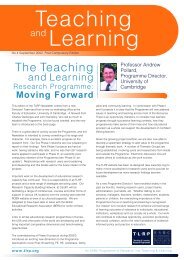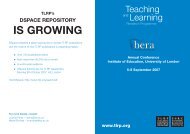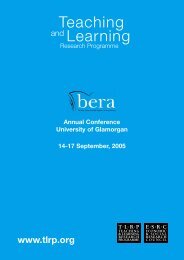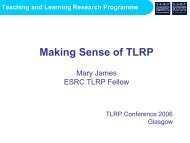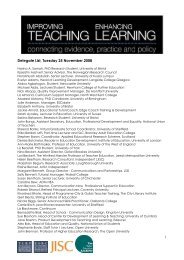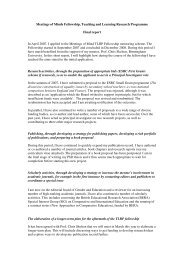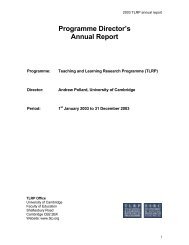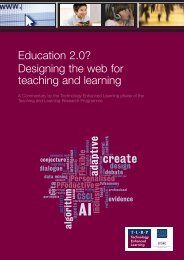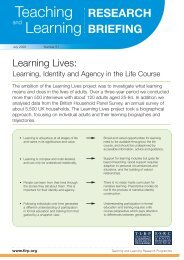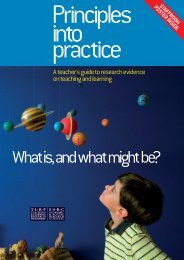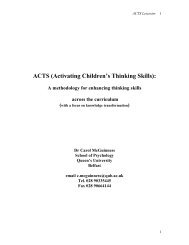Issue 2: the qualitative foundation of quantity - Teaching and ...
Issue 2: the qualitative foundation of quantity - Teaching and ...
Issue 2: the qualitative foundation of quantity - Teaching and ...
Create successful ePaper yourself
Turn your PDF publications into a flip-book with our unique Google optimized e-Paper software.
Computer-mediated communication in educational research<br />
(Continued from page 8)<br />
go’ electronic form. When interviewing<br />
via <strong>the</strong> internet, for example,<br />
data require little or no additional<br />
transcription - with a minimum <strong>of</strong><br />
alteration <strong>the</strong> text from online interviews<br />
can easily be tailored for any<br />
word processor or computer-based<br />
<strong>qualitative</strong> analysis package. As<br />
well as obviously saving <strong>the</strong> researcher<br />
time <strong>and</strong> money this also<br />
eliminates any biases introduced<br />
through incorrect transcription. With<br />
online interviewing <strong>the</strong> data that are<br />
eventually analysed are exactly as<br />
<strong>the</strong> interviewee dictated.<br />
Caveats to Consider<br />
Given such advantages it is little<br />
wonder that educational researchers<br />
are beginning to use CMC in its<br />
various guises as <strong>the</strong> basis for research<br />
projects. However, aside<br />
from practical savings on <strong>the</strong> part <strong>of</strong><br />
<strong>the</strong> researcher, <strong>the</strong>re are o<strong>the</strong>r less<br />
obvious factors that should be considered<br />
before adopting a research<br />
strategy based around CMC.<br />
• Limitations <strong>of</strong> Population<br />
The primary limitation <strong>of</strong> CMC is <strong>the</strong><br />
extremely self-selective population<br />
that it covers - limited to those individuals<br />
with access to <strong>the</strong> technology<br />
needed to sustain it. Despite<br />
steady increases in ownership <strong>of</strong><br />
ICT repeated studies show that<br />
populations <strong>of</strong> ‘users’ remain substantially<br />
skewed along lines <strong>of</strong><br />
class, race, age, income <strong>and</strong> gender<br />
(Selwyn <strong>and</strong> Gorard 2002).<br />
We should not be fooled into thinking<br />
that this limitation <strong>of</strong> coverage<br />
amongst <strong>the</strong> general public is not<br />
relevant to research focused on<br />
educational institutions. For example,<br />
despite all predictions, computer-based<br />
communication such<br />
as e-mail remains a minority pasttime<br />
among many young people -<br />
rapidly usurped by mobile phone<br />
text-messaging. Even if students do<br />
have <strong>of</strong>ficial e-mail addresses at<br />
school, college or university many<br />
prefer instead to use temporary addresses<br />
via services such as Yahoo<br />
or Hotmail which will not be easily<br />
accessible to researchers. The lack<br />
<strong>of</strong> permeation <strong>of</strong> e-mail into schools<br />
has been reflected in <strong>the</strong> government<br />
recently dropping its target for<br />
50 per cent <strong>of</strong> children to have a<br />
personal email address at school by<br />
2002. Similarly, teacher <strong>and</strong> school<br />
use <strong>of</strong> e-mail is also not proving to<br />
be as comprehensive as was expected<br />
with many schools using<br />
general school or class-wide email<br />
addresses.<br />
Even with ‘ICT active’ populations<br />
in educational settings <strong>the</strong> use <strong>of</strong><br />
CMC is not straightforward. The<br />
problem <strong>of</strong> information overload<br />
means that research via CMC runs<br />
<strong>the</strong> risk <strong>of</strong> becoming marginalised<br />
as a form <strong>of</strong> electronic ‘junk mail’.<br />
Unsolicited attempts to gain information<br />
via e-mail by researchers<br />
(however genuine) are <strong>of</strong>ten being<br />
simply ignored by <strong>the</strong> deluged recipient<br />
at <strong>the</strong> o<strong>the</strong>r end <strong>of</strong> <strong>the</strong> line.<br />
The speed <strong>of</strong> CMC also lends it an<br />
certain ephemerality which may<br />
compromise its effectiveness as a<br />
research tool - unlike <strong>the</strong> st<strong>and</strong>ard<br />
mail questionnaire or interview <strong>the</strong><br />
respondent can discard CMC messages<br />
at <strong>the</strong> touch <strong>of</strong> a button.<br />
• CMC as a ‘different’ form <strong>of</strong><br />
communication<br />
Researchers sometimes forget that<br />
ICT also leads to different data being<br />
collected than would be <strong>the</strong><br />
case with conventional methods,<br />
primarily due to <strong>the</strong> distinctiveness<br />
<strong>of</strong> CMC as a hybrid form <strong>of</strong> oral <strong>and</strong><br />
written language. Although many<br />
instances <strong>of</strong> CMC do resemble written<br />
forms <strong>of</strong> speech such communication<br />
<strong>of</strong>ten relies on a simplified<br />
register due to <strong>the</strong> increased effort<br />
needed to input what you want to<br />
say. For example, CMC can be<br />
loose in terms <strong>of</strong> conventional<br />
punctuation <strong>and</strong> spelling - <strong>of</strong>ten relying<br />
heavily on acronyms, abbreviations<br />
<strong>and</strong> new forms <strong>of</strong> textual<br />
representation <strong>of</strong> feelings to overcome<br />
<strong>the</strong> lack <strong>of</strong> non-verbal communication.<br />
CMC is also seen as<br />
altering <strong>the</strong> organisation <strong>of</strong> communication.<br />
Due to <strong>the</strong> lack <strong>of</strong> proximity<br />
with o<strong>the</strong>rs <strong>and</strong> differing time<br />
constraints, <strong>the</strong> traditional notions<br />
<strong>of</strong> opening <strong>and</strong> closing conversations,<br />
turn-taking <strong>and</strong> interrupting<br />
are <strong>of</strong>ten altered or even ignored<br />
altoge<strong>the</strong>r in all but <strong>the</strong> most formal<br />
<strong>of</strong> computer mediated settings.<br />
Thus data ga<strong>the</strong>red via CMC are<br />
not necessarily what people would<br />
have said or written in<br />
‘conventional’ situations.<br />
• <strong>Issue</strong>s <strong>of</strong> Power <strong>and</strong> Ethics<br />
CMC based research should also<br />
be seen as ‘different’ in terms <strong>of</strong><br />
power relations between researchers<br />
<strong>and</strong> participants. On <strong>the</strong> one<br />
h<strong>and</strong> this can be seen as a good<br />
thing. For example, it is argued that<br />
electronic communication sets up a<br />
‘democratisation <strong>of</strong> exchange’ that<br />
eludes more conventional research<br />
methodologies. Interviewing via<br />
CMC reduces <strong>the</strong> problem <strong>of</strong> interviewer<br />
‘effect’, both in <strong>the</strong> form <strong>of</strong><br />
visual <strong>and</strong> non-verbal cues <strong>and</strong> effect<br />
<strong>of</strong> interviewer status. It also can<br />
reduce <strong>the</strong> problem <strong>of</strong> dominant<br />
<strong>and</strong> shy participants, particularly in<br />
a focus group situation. In this way,<br />
electronic research goes a long way<br />
to alleviating some <strong>of</strong> <strong>the</strong> interpersonal<br />
problems commonly associated<br />
with conventional face-t<strong>of</strong>ace<br />
techniques.<br />
Yet <strong>the</strong> disembodiment <strong>of</strong> CMC<br />
does not automatically lead to unbiased<br />
research. Firstly is <strong>the</strong> issue <strong>of</strong><br />
(mis)representation. The lack <strong>of</strong> visual<br />
identifiers when communicating<br />
via technology gives people <strong>the</strong> opportunity<br />
to describe <strong>and</strong> present<br />
<strong>the</strong>mselves to o<strong>the</strong>rs in different<br />
ways. For example people can intentionally<br />
construct an artificial<br />
self - altering notions <strong>of</strong> gender,<br />
age, social class, race, disability<br />
<strong>and</strong> sexuality as <strong>the</strong>y wish (for good<br />
or bad). Of more concern however<br />
are warnings that interactions via<br />
CMC are not as democratic <strong>and</strong> unhierarchical<br />
as one may first assume,<br />
with online interactions <strong>of</strong>ten<br />
proving to be structured in terms <strong>of</strong><br />
gender <strong>and</strong> computer competence<br />
(Mann & Stewart 2000).<br />
Finally, from an ethical perspective,<br />
issues <strong>of</strong> anonymity are also not<br />
straightforward. For example using<br />
(Continued on page 10)<br />
April 2002 Building Research Capacity 9



